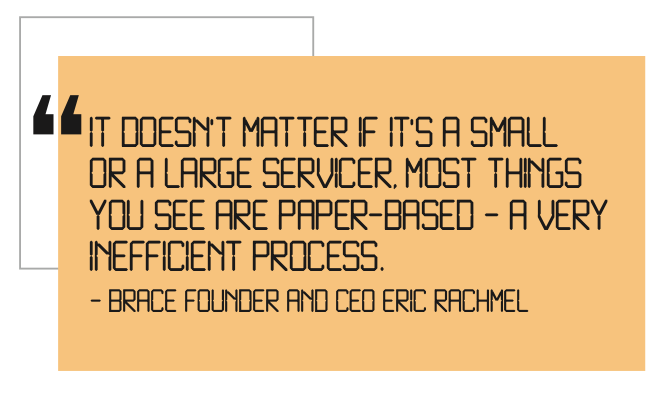
One click, your mortgage process begins. Another click, that mortgage loan is pre-approved. Five minutes pass and you are ready to buy a home.
The digital application process for single-family mortgages has flourished with new technology, new companies entering the space and new capabilities that, even just 10 years ago, we wouldn’t have thought possible.
Borrowers can sign closing papers on a new home remotely so that they don’t have to miss hours of work. Travelers can close on their home from the other side of the world. The credit invisible, or those with no credit score, can learn more about their financial situation and what they can do to prepare to buy a home after a quick and painless application process.
But if you fast forward just a few weeks, to when a borrower is getting settled into their new home, the experience changes dramatically. Their mortgage loan is sold and their servicer steps in to introduce themselves. The smooth digital process is suddenly transformed into a rough, paper-heavy and confusing process.
“It doesn’t matter if it’s a small or a large servicer, most things you see are paper-based – a very inefficient process,” Brace Founder and CEO Eric Rachmel explained to HousingWire. “I mean, you have to walk before you run in that we need a few servicers to really invest time and money in shoring up their infrastructure. Infrastructure is largely 40 to 50 years old at this point.”
The mortgage origination process takes just about a month or two, while most of the lifecycle of the loan takes place in the mortgage servicing department. Even with the best mortgage origination process, consumer’s overall experience will plummet after moving to the next phase, where they could encounter years of disappointing service under a largely paper-based servicer.
Rachmel explained that technology providers need to focus on how servicers are accessing data in order to provide meaningful insights into that data.
As it stands now, it’s a lot of pushing paper back and forth. For example, servicers often receive paper packets offline, scan them and repurpose them, before rescanning them and printing them out. It’s a really inefficient process, to say the least. And where many originators are making serious investments in AI, that kind of technology is still in its infancy in many servicing shops, if it exists at all.
“We want to get there and push that industry forward with using smart AI, but right now, what we’re doing is we’re in that phase of bringing online a lot of manual processes and offline processes into meaningfully digital workflow processes,” Rachmel said.

Servicers slow to adopt new tech
The latest survey from J.D. Power shows servicers have a lot of ground to make up when it comes to earning the trust of consumers. The J.D. Power 2019 U.S. Primary Mortgage Servicer Satisfaction Study shows that the involuntary nature of this relationship, combined with an industry-wide focus on efficiency and cost controls, has resulted in mortgage servicers earning some of the lowest customer satisfaction and Net Promoter Scores of any industry group studied by J.D. Power.
“Mortgage servicers are really missing an opportunity to build the kind of goodwill with their customers that has proven to translate directly to increased advocacy and repeat business,” said John Cabell, J.D. Power director of wealth and lending intelligence. “The industry’s laser focus on lowering costs, managing regulatory compliance and minimizing delinquencies has come at the expense of customer experience. It is negatively affecting customer trust in their brands.”
And the survey showed that some of the low levels of trust were due to digital tools not keeping pace.
About 60% of customers are accessing information via their mortgage servicer’s website and just 31% are accessing information via mobile, both of which lag other financial sectors in retail banking, the survey showed. Despite relatively low usage, overall satisfaction is highest among customers who use digital self-service channels. Digital utilization varies considerably by servicer, with best-in-class brands showing utilization rates that are about 20% higher than the industry average for key functions such as checking alerts and messages and reviewing FAQs.
Servicers need to be ready for change, and ready to work for that change. Romi Mahajan, chief marketing and revenue officer at Quantarium, which offers AI-driven real estate analytics, explained that technology is not an easy fix.
“Technology, no matter how powerful, is never a silver bullet,” Mahajan told HousingWire. “When new technologies enter the picture, process, culture and mindset have to change as well. Even if an organization is willing to bear the initial cost of innovation or even of adoption of others’ technology innovations, it will fail if not prepared to answer the questions that technology inevitably asks – like, ‘Should we do X differently?’”
But are servicers prepared for the major tech changes that it would take to adopt AI and machine learning into their processes?
“We’re pushing that side very hard and servicing and servicers are willing and able to adopt those technologies; now AI is driving insight – I think that’s a longer term goal,” Rachmel said. “And I think there are some substantial use cases for servicers that they’re not ultimately thinking about or really in a place to accomplish today to provide that better customer experience. I think you saw J.D. Power and Associates, and how they rank servicers, I think the fundamental problem is really that the technology today isn’t sufficient to drive automation and drive AI.”
Because the revenue flows in from the origination front, lenders are more likely to spend money for new technology for this sector. As a result, very few solution providers even offer servicing technology, knowing it is unlikely revenue will be allocated on that front.
“I think servicers today have all of the knowledge base, and very little technology to drive them into the future of where we need to be in terms of servicing,” Rachmel said. “Most of the folks in origination get all the best technology because it’s a revenue center and servicing has been largely left behind in terms of spend.”
There are also other small barriers, such as trust issues between vendors and servicers. There is a history of vendors over-promising and under-delivering, according to Rachmel. In order for servicers to go all-in with servicing tech, they need more vendors to create products they can trust. But this barrier can be easily overcome with the right partner – once servicers are given the revenue they need to invest in new technology.
One thing is clear – servicers need to update their mortgage technology, and they need to do it soon.
What AI can do today
Artificial intelligence used to be something that we only dreamed about, or watched on sci-fi movies where robots came to life and even developed personalities.
While we aren’t quite at iRobot levels of AI, it is no longer just a buzzword – it is solving real problems and creating real opportunities for professionals and consumers across every industry.

Artificial intelligence has advanced beyond what we would have expected even just a few years ago. Google recently released a video of Google voice making a reservation at a restaurant. The Google robot called the restaurant, answered all of the questions the restaurant had and even repeated information when asked. The entire reservation was made and the restaurant never even knew it was talking to a machine.
And that’s just one example of many of what AI and machine learning can do.
Take, for example, Brace. This AI startup enables mortgage servicers to react promptly to a delinquency event and quickly determine the best available outcome for everyone involved. Its software streamlines content and messaging while reducing errors and accelerating the decision-making process, with a goal of creating a better experience for the borrower and saving servicers money.
“Servicing is very much about knowing your customer not only in the present state but being able to predict where they are going in future states, based on intelligent guessing, otherwise known as analytics,” Mahajan explained. “AI, especially ground-up, explainable AI, is perfectly suited to this task of knowing the customer.”
AI is changing the way we interact and process information. It is more than just a buzzword, it is creating real change, and the tech experts have their eye on servicing next.
Not just better for consumers
Despite all of these advances, servicers remain behind, with technology that is decades old.
Servicers are often overlooked when it comes to technology updates because of their involuntary relationship with consumers.
But it’s not just consumers who would benefit from more technology, including AI and machine learning, in servicing. Servicers would also save time and money by creating more efficient workflows.
A recent report from Tavant Technologies pointed out one of the greatest applications for machine learning in servicing is to help servicers prioritize who to call, the best day of the month to call and send reminders to call them.
The servicing industry needs an update, and some companies are already working to bring technology into the sector and revolutionize the way the industry works.
With the use of digital agents and bots in key areas of the business, LoanCare, the nation’s third largest subservicer and a 2018 HousingWire Tech100 winner, built the first digital servicer in the mortgage industry. LoanCare’s proprietary Eureka Cloud Data Platform is a servicing data access platform that delivers hundreds of data extracts and report deliverables every day for clients.
Eureka quality control bots use robotic process automation technologies to perform CMAP and other data quality validation controls, to alert LoanCare to quality issues, to be resolved and resubmitted; if there are no issues, the bots will deliver the data deliverables to the correct secure file transfer folder for output.
As a result of its innovations, LoanCare received a reaffirmation of an above average rating from S&P Global at the end of 2019.
“We expect LoanCare to remain a competitive servicer in the residential marketplace,” S&P Global stated.
Mortgage servicers could be utilizing AI to accelerate responsiveness, shorten the mortgage application process and even protect servicers and borrowers from fraud and cyber threats. AI also brings other benefits such as reduced credit losses, lower agency recourse risk, better risk-adjusted margins and lower servicing costs.
For example, The Money Source currently uses Joy, its automated assistant, in its borrower portal 24/7 to assist a borrower with basic loan and payment questions. This year, TMS plans to further advance Joy’s technology through AI and provide a more extensive repertoire for its borrowers to have access to. TMS is even in the process of allowing borrowers to not only pay with debit cards, but through Venmo, PayPal and Amazon.
And numbers don’t lie. Unlike many in the servicing industry, TMS boasts a 98% consumer satisfaction score – nearly unheard of in this industry.
Even back in 2018, companies began integrating AI into their servicing solutions. For example, nonbank mortgage lender and servicer Mr. Cooper announced the launch of a new mobile app that utilizes artificial intelligence to reimagine the homeownership experience with tools to help homeowners optimize their personal balance sheets.
And Black Knight acquired HeavyWater, a provider of artificial intelligence and machine learning, saying, “With the cost of origination and servicing at, or near, all-time highs, AIVA is poised to help increase efficiencies for Black Knight clients. AI, machine learning and neural network solutions are the future of delivering enhanced productivity and capabilities to our clients, and we are very excited about the potential HeavyWater has to offer.”
Servicers who use AI and machine learning often see a reduction in collection calls made, higher customer satisfaction and even lower delinquencies.
“Prudent lenders can use payment pattern data, credit bureau data, and other transactional data feeds to build ML models that can predict the likelihood of prepaying within the next 30 days and prompt them to take defensive measures such as pre-emptive refinance offers using sweeteners such as rebates and zero-cost refinances,” Tavant said in a recent report. “This is more convenient and cost-effective for the customer and lender to retain the long-term servicing revenue stream.”
“By creating a dedicated low cost ‘defensive refi’ unit that does not have the sales compensation structure of typical loan officers, the lender can make an origination profit as well,” the report continued.
In mortgage servicing, delinquencies and foreclosures represent one of the largest sources of revenue loss as foreclosures are drawn out over many months, resulting in a loss of interest during the non-performing period. As it stands now, servicing is in a good place as mortgage delinquencies continue to hit new lows. At the end of 2019, foreclosure starts were down nearly 15% from the year before, according to reports from ATTOM Data Solutions.
But investments in machine learning and AI can help continue to reduce those numbers, and protect servicers in the event of a market downturn.
“Machine learning models built on payment pattern data, credit bureau and other feeds to create a ‘likelihood of default’ model can give the servicer a heads-up,” Tavant stated. “The servicer can then assign the loan to a ‘work-out’ unit to work proactively with the borrower to explore non-foreclosure strategies.”
Servicers who take these steps will see greater customer cure rate, home retention and satisfaction, lower losses and charge-offs, lower delinquencies and higher servicing revenue.
And machine learning models trained on historical loan data and macro-economic data can be used to value and hedge the portfolio. The models used for this purpose are typically default and prepayment models, which may then be used to forecast and hedge the value of the portfolio using the most appropriate hedging securities instruments.
When we think of where we were a decade ago, back in 2010, we have clearly come a long way. And yet, we have only scratched the surface of the possibilities behind AI and machine learning.
But in order to see true change servicers have to be willing to invest in it, work for it and not be afraid of it. Now is the time to make those changes. Because those that don’t will only find themselves falling further and further behind. The servicers that come out on top, that make it to 2030, will be the ones that weren’t afraid to try something new.





